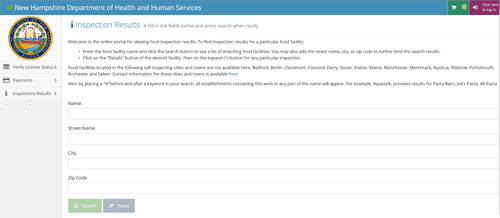Learn About Food Inspections & View Results
Food Protection licenses and inspects nearly 4600 food service establishments in NH. There are many more regulated by local health officers in 15 self-inspecting communities.
To find NH food inspection results, visit our Online Portal.
View Food Inspection Results
Inspection results:
- Are available for food establishments-such as restaurants, retail stores, schools, etc.
- Go back as far as January 2017
- Include inspection data for NH cities and towns served by Food Sanitation. It does not include results for establishments operating in the 15 self-inspecting communities
- Include routine, licensing and follow-up inspection results
Inspection Results page will prompt you to enter information related to your search.

Program Information
Learn More about Food Safety Inspections
Food establishments that sell or serve food to the public must obtain an annual license and be inspected by Food Protection. This includes restaurants, food and espresso carts, coffee places, delis, the fresh food sections in grocery stores, schools where food is sold, and more.
Food Protection licenses and inspects nearly 4600 food service establishments in NH. There are many more regulated by local health officers in 15 self-inspecting communities.
The purpose of inspections is to assure that food is being handled properly from preparation through serving. Inspectors observe kitchen workers' food handling practices, assure equipment is working properly, take food temperatures, inspect refrigerators and storage areas, assure water temperatures, and correct level and use of sanitizers. All violations are documented, and a corrective action plan is implemented immediately.
Three types of violations are recorded on the inspection report:
- "Priority violations" are food handling practices that, when not done properly, are most likely to lead to foodborne illnesses. These include:
- controlling temperature, such as cooking meats to the right temperature to kill food borne disease germs, keeping food hot enough until it is served, and keeping food cold enough
- cooling food properly, washing hands, and using utensils instead of bare hands on "ready to eat" food
- storing food
- serving practices
- “Priority Foundation violations” is an item or situation that may cause one or more Priority violations. For example, a handsink that is blocked or lacking paper towels or soap.
- "Core violations" are primarily maintenance and sanitation issues that are not likely to cause a foodborne illness.
Inspection results are shown using a color rating system — green, yellow, or red — that is driven by priority items being in or out of compliance. Priority violations are the more serious violations that have been found to contribute to foodborne illness or injury.



